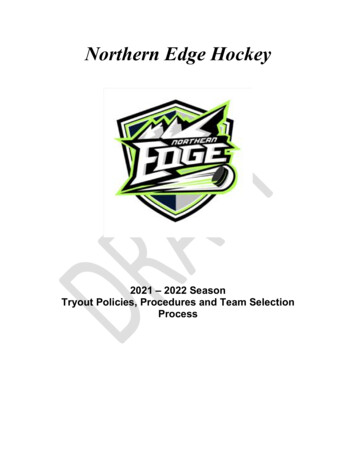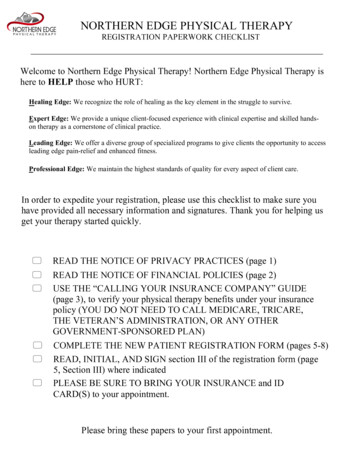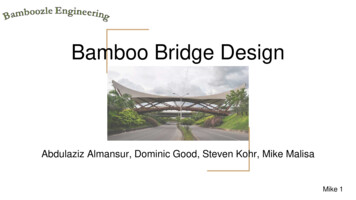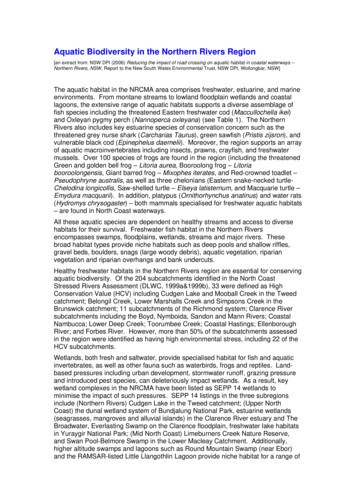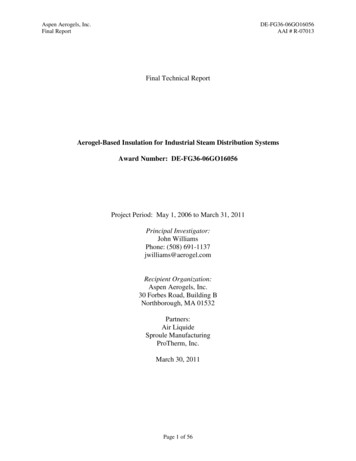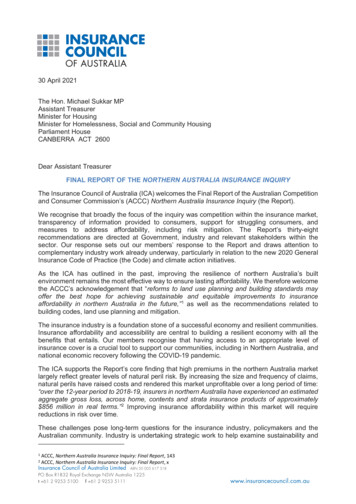
Transcription
30 April 2021The Hon. Michael Sukkar MPAssistant TreasurerMinister for HousingMinister for Homelessness, Social and Community HousingParliament HouseCANBERRA ACT 2600Dear Assistant TreasurerFINAL REPORT OF THE NORTHERN AUSTRALIA INSURANCE INQUIRYThe Insurance Council of Australia (ICA) welcomes the Final Report of the Australian Competitionand Consumer Commission’s (ACCC) Northern Australia Insurance Inquiry (the Report).We recognise that broadly the focus of the inquiry was competition within the insurance market,transparency of information provided to consumers, support for struggling consumers, andmeasures to address affordability, including risk mitigation. The Report’s thirty-eightrecommendations are directed at Government, industry and relevant stakeholders within thesector. Our response sets out our members’ response to the Report and draws attention tocomplementary industry work already underway, particularly in relation to the new 2020 GeneralInsurance Code of Practice (the Code) and climate action initiatives.As the ICA has outlined in the past, improving the resilience of northern Australia’s builtenvironment remains the most effective way to ensure lasting affordability. We therefore welcomethe ACCC’s acknowledgement that “reforms to land use planning and building standards mayoffer the best hope for achieving sustainable and equitable improvements to insuranceaffordability in northern Australia in the future,” 1 as well as the recommendations related tobuilding codes, land use planning and mitigation.The insurance industry is a foundation stone of a successful economy and resilient communities.Insurance affordability and accessibility are central to building a resilient economy with all thebenefits that entails. Our members recognise that having access to an appropriate level ofinsurance cover is a crucial tool to support our communities, including in Northern Australia, andnational economic recovery following the COVID-19 pandemic.The ICA supports the Report’s core finding that high premiums in the northern Australia marketlargely reflect greater levels of natural peril risk. By increasing the size and frequency of claims,natural perils have raised costs and rendered this market unprofitable over a long period of time:“over the 12-year period to 2018-19, insurers in northern Australia have experienced an estimatedaggregate gross loss, across home, contents and strata insurance products of approximately 856 million in real terms.” 2 Improving insurance affordability within this market will requirereductions in risk over time.These challenges pose long-term questions for the insurance industry, policymakers and theAustralian community. Industry is undertaking strategic work to help examine sustainability and12ACCC, Northern Australia Insurance Inquiry: Final Report, 143ACCC, Northern Australia Insurance Inquiry: Final Report, x
affordability of insurance markets over the longer-term, and we welcome the opportunity tocollaborate with Government on these initiatives.The ICA and its members also support the Report’s recommendations directed at stategovernments, particularly Western Australia, the Northern Territory and Queensland, in relationto stamp duties. Abolishing stamp duties on insurance will have an immediate impact onaffordability since residents in these states pay up to 10 per cent more on top of the premiumsthey pay to insure their home and principal financial asset. 3 For example, Western Australiapresently levies a stamp duty on gross premiums and CTP premiums of 10 per cent after GST –a 21 per cent impost on top of the premiums paid by householders. 4Finally, while the focus of the Report is northern Australia, several Recommendations relate tothe broader insurance market. These recommendations are in relation to making it easier forcustomers to search for, and compare, insurance products; choose the right amount of cover andassistance for consumers experiencing hardship. While the ICA tentatively supports deeperexamination of many of these broader Recommendations, it is critical that focus not be lost onthe specific needs and challenges of the northern Australian market. Further, care should be takento align with other ongoing initiatives and to minimise the risk that additional regulatoryinterventions will have unintended consequences in the broader market.Finally, the ICA notes that there are some recommendations where industry has strong concernsand which are not supported. More detail is provided on these in Attachment A, but we wouldhighlight the following recommendations in this regard: Rec 18.7: National home comparison website. Rec 18.10: Disclosure where premium increases are capped. Rec 20.2: Giving consumers more control over how home (building) claims are settledFurther detail on the ICA and members’ views on the various themes identified in the ACCC’sReport are at Attachment A with a summary table provided at Attachment B. The ICA looksforward to working with Government on its consideration of the Recommendations. egulatoryAffairs(areddy@insuranceouncil.com.au, 02 9253 5176) if you have any questions in relation to ourresponse.Yours sincerelyAndrew HallExecutive Director & CEO34ACCC, Northern Australia Insurance Inquiry: Final Report, 55ACCC, Northern Australia Insurance Inquiry: Final Report, 552
OverviewAttachment AThe Insurance Council commends the ACCC for its work over three years on the northernAustralia insurance inquiry and reiterates support for the Report’s core finding that high premiumsin the northern Australia market reflect greater levels of natural peril risk.Notwithstanding the focus on northern Australia, the Report makes Recommendations about thebroader functioning of insurance markets. These Recommendations would have a national impactand should be considered in light of the overall Australian insurance market. As noted above, it iscritical not to lose sight of the specific issues impacting the northern Australia market. While theICA is supportive (or supportive-in-principle or partially supportive) of many of these broaderRecommendations, others require further consideration or are not supported by industry.Our commentary in this Attachment focuses on each of the thematic areas outlined within theACCC’s Report, discussing specific recommendations where necessary. The thematic areas are:(A) Making it easier to search for, and compare, insurance products(B) Choosing the right amount of cover(C) Dealing with conflicts of interest(D) Addressing affordability concerns(E) Improving consumer’s rights(F) Reducing risk and building betterData SourcesBefore commenting on the substance of the recommendations within the ACCC’s Report, we wishto acknowledge that the final report is an analysis of extensive data, information and feedbackfrom industry, residents, consumer groups and communities across northern Australia. Despitethe limitations of some of its data sources, which the ACCC itself acknowledges, we support theview that non-insurance is a critical issue for those living in communities in northern Australia.The ACCC’s data sources place non-insurance in northern Australia for homes (building) around20 percent compared to 11 per cent in the rest of the country. 5 The Insurance Council’s policy-inforce data collection, due to occur later this year, will provide more data to test the precise levelof insurance.(A) Making it Easier to Search for, and Compare, Insurance ProductsThis thematic area (as well as the next two, Choosing the Right Cover and Dealing withConflicts of Interest) includes several recommendations around disclosure requirements.The ICA is supportive of many of these broader Recommendations. Many Recommendationswarrant further consideration, both with respect to detailed implementation at an operational leveland to avoid unintended consequences. Insurance remains a critical tool for Australians tomanage risk, and insurance pricing remains a key signal of risk. Any additional regulatory5ACCC, Northern Australia Insurance Inquiry: Final Report, 2643
interventions should be structured to minimise the distortionary effect on competition and marketsignals.An illustrative example are the several recommendations that impose new requirements aroundconsumer disclosures. Any additional such requirements should be considered within the overallcontext of information that consumers already receive. This should include consideration of theimpact on consumer behaviour of any additional information and, to the extent possible, be basedon behavioural research. This would permit a holistic consideration of how best to tailorinformation to enable customers to make informed decisions about their own insurance needs(noting that insurance is frequently tailored to an individual). Existing research shows thatproviding more information does not necessarily result in consumers making better decisions inrelation to their insurance coverage. 6Other recommendations within this thematic area are not supported by industry, notably: theestablishment of a national home insurance comparison website and disclosure where premiumincreases are capped.National home insurance comparison websiteThe industry does not support the establishment of a national home insurance comparisonwebsite (Recommendation 18.7). There are already several private sector products in the market.The ACCC Report itself provided evidence that, given the competitive market dynamics forinsurance in northern Australia, price comparison websites would likely act to put upward (ratherthan downward) pressure on premiums. The insurance market in northern Australia is comprisedof a small number of insurers who are each seeking to limit their exposure to natural perils throughdistribution and pricing strategies. A price comparison website, all else being equal, wouldencourage consumers towards insurance products at the lower end of the spectrum. In turn, thiswould place upward pressure on premiums as insurers sought to mitigate their risk exposure. TheACCC Report itself acknowledged this dynamic: 7 insurers try to limit their exposure in high risk areas (or their concentration risk) due to thelosses that may be faced in the event of a catastrophe. As a result, in many high risk areas,insurers do not actively seek to increase their market share. They do so by either not writingnew business in a certain location or of a certain risk profile, or by increasing premiums.As additional point is that comparison websites of this nature have been considered by previousinquiries over several years. The Financial System Inquiry discussed their potential use but didnot make a positive recommendation for a government-established website. 8 Likewise, theGovernment response to the 2017 Senate References Committee report, Australia’s GeneralInsurance, noted that the Report “provides limited evidence on the benefits that would begenerated by a government-funded comparison website” and that “there are already a number ofprivate sector companies providing these services”. 9Australian Securities and Investments Commission (ASIC) and Dutch Authority for the Financial Markets, Disclosure: Why itshouldn’t be the default, Insurance Council of Australia, Effective Disclosure Taskforce, Too long; didn’t read – Enhancinggeneral insurance disclosure Report7 ACCC, Northern Australia Insurance Inquiry: Final Report, 1268 Financial System Inquiry, Final Report, p230-319 Australian Government, Response to the Senate Economics Committee Report: Australia’s General Insurance Industry,Response to Recommendation 864
Disclosure of capped premium increasesFinally, the industry does not support disclosure where premium increases are capped(Recommendation 18.10). This recommendation may have competition implications, given thecommercially sensitive nature of insurer risk assessments and datasets. Policies are designed tobe priced on an annual basis using dynamic information. Any estimate of future premiumincreases would be highly complex. It would be variable in nature, inconsistent between insurersand have the potential to provide confusing price signals to consumers. Subsequent changes torating factors may make any advised premium increases incorrect, thus raising the unintendedconsequences of consumer decisions ultimately causing financial disadvantage or, alternatively,restricting the insurers ability to address new or unexpected changes to cost.(B) Choosing the Right Amount of CoverThe ICA and its members are supportive of recommendations aimed at supporting consumerschoose the right amount of cover.Recommendation 18.4 states that insurers should estimate sum insured and supply this sum onthe renewal notice. While the ICA and members support the objective of better informingconsumers and reducing under-insurance, customers themselves are usually better placed toassess the value of their property. Therefore, insurers often provide customers the tools to dotheir own estimates, such as online calculators. In further recognition of the exigencies ofestimating sum insured, insurers often have in place procedures such as policy uplifts.There are also more fundamental questions around how this recommendation would functionwithin the current advice regime. This matter is currently under consideration by ASIC as a partof CP332, Promoting Access to Affordable Advice for Consumers.Furthermore, any changes to the disclosure regime would need to consider interactions withongoing Treasury work on the standard cover review, including standardisation of definitions ofprescribed events. Members continue to support industry consideration of standard cover underthe auspices of a Treasury-led review given the potential competition implications.(C) Dealing with Conflicts of InterestThe ICA and its members are of the view that Recommendations 19.2 (strata managers to beremunerated by body corporate only) and 19.3 (clear disclosure of products considered andremuneration) require further consideration. With respect to Recommendation 19.2, considerationshould be given to other options that would meet the same aim, including any flow-on effects tostrata manager remuneration. With respect to 19.3, brokers typically conduct a detailed review ofan individual’s circumstances before recommending a product and may be faced with placingrisks that are not covered by mainstream products.Recommendation 19.1 is to extend the ban on conflicted remuneration to insurance brokers.Given the unique nature of general insurance and the market structures within which it is sold, theindustry does not support a ban on commission-based remuneration arrangements. Additionally,the Financial Services Royal Commission (FSRC) recommended (FSRC Recommendation 2.3)that there should be a review by Government in consultation with ASIC of the effectiveness ofmeasures that have been implemented by the Government, regulators and financial servicesentities to improve the quality of financial advice. Among other things, this included (FSRCRecommendation 2.6) whether the exemptions to the ban on conflicted remuneration for general5
insurance products remains justified. These issues are best considered within the context of thatreview.(D) Addressing Affordability ConcernsThe ICA supports Recommendation 3.1, to abolish stamp duty on home, contents and stratainsurance products. Given the importance of affordability of insurance and the potentialimplications of non or underinsurance for the Government and the community, we believe it istime to act to remove specific imposts on insurance as has previously been recommended by thisand other government inquiries. However, if this is not possible, then we are open to the possibilityof amending the stamp duty basis away from retail premiums towards some other metric, suchas the re-basing of stamp duty with reference to the sum insured value rather than premium value(Recommendation 3.2). Care would need to be taken to ensure that such a change does notcreate an additional incentive for residents to underinsure (or even not insure) their properties.The Report canvasses other measures to improve affordability and availability in Chapter 8,including consideration of subsidies, reinsurance pools, government insurers, mitigation, amongothers. Ultimately, the ACCC has recommended direct subsidies (Recommendation 8.1).As announced in February this year, the ICA has commissioned former insurance executive andregulator John Trowbridge to undertake a review of potential options to address insuranceaffordability and availability following a number of inquiries and reviews over the past decade thatfocussed on high-risk sectors and potential coverage gaps for some groups of consumers andbusinesses. The review includes a consideration of the ACCC’s northern Australia InsuranceInquiry. While the work does explore proposals for a potential reinsurance pool for climate relatedrisks in northern Australia, there are still many critical policy issues to be resolved.The most important of these are: Who pays for the cost subsidy that would be required – taxpayers or other policyholders;The role of mitigation to reduce the risk of weather events’ impacts and improve the resilienceof exposed communities;How do we stop enabling new development that is not fit-for-purpose in areas of high naturalperil risk; andThe removal of state taxes and duties that only exacerbate affordability issues.Understandably, insurers have a range of views on this issue but share a commitment toaddressing insurance affordability and availability over the short and long-term and will continueto engage with affected communities, stakeholders and governments on this important debate.(E) Improving Consumer’s RightsThe Insurance Council has developed the General Insurance Code of Practice (the Code) whichrequires insurers, and other industry participants, who have adopted the Code to provide servicesto their customers in an open, fair and honest way. The Code also gives customers specific rightsin a range of situations, such as when they are buying insurance, making a claim or experiencingfinancial difficulty.The Insurance Council intends to apply for ASIC approval of the Code and is awaiting ASIC’sregulatory guidance on approval of financial sector codes (RG 183) to be updated for enforceablecode provisions, which is expected to take place by the end of this year.6
In relation to the recommendation for Centrepay to be offered by insurers as a payment option(Recommendation 15.2), members note that Centrepay poses significant challenges and is notconsidered the most effective way to provide customers with flexible payment options. It is ourview that Centrepay requires a program of modernisation. In the meantime, insurers continue toexplore alternative payment solutions to Centrepay so insurance may be as broadly accessibleas possible to all members of the Australian community.Finally, the ICA and its members do not support Recommendation 20.2, which states that“consumers should be provided with the right to choose whether their home building is settledthrough a cash settlement or with a repair/rebuild managed by the insurer”.As a general principle, we are of the view it is more appropriate to provide a customer with keyinformation to assist with understanding how a cash settlement works, if one is offered, ratherthan giving the right to choose the method of settlement.Insurers generally prefer repairs/rebuilds over cash settlements for several reasons. For example,the customer will receive a lifetime guarantee on the workmanship of repairs from their insurerand will not need to appoint a building manager or manage the entire repair process themselves(including delays, issues, quality and cost); and customers will benefit from being able to rely onthe insurer’s network of qualified building and repair professionals. There will always be situationswhen a cash settlement may be the only feasible option to settle the claim, for example if thereare no repair or rebuild options available for a customer to choose from due to the area rezonedor unsafe for development.(F) Reducing Risk and Building BetterThe ICA welcomes the Report’s focus on improving resilience in the built environment in northernAustralia. The ICA has previously stated that this is the most promising path towards a resilientnorthern Australia insurance market, and we therefore welcome this focus. Our comments on thisthematic area outline ongoing industry work and draw attention to complementary initiatives.The insurance industry via the ICA regularly partners with local government and otherstakeholders to progress work on building resilience. 10 For example, the ICA is currently workingwith Queensland Fire and Emergency Services and Geoscience Australia on a severe windhazard assessment project. This project will include an assessment of future cyclone risk anddamage/loss to residential homes within six local government areas in Queensland and will makerecommendations about optimal retrofits and how to fund them. Other examples of work beingundertaken by the ICA include: Building Resilience Rating Tool: Developed by the ICA over the course of the last decadeas part of a broad set of initiatives to disclose risk information to the customer about theirhouses and encourage greater levels of due diligence during house transactions. Where we Build, What we Build: This project delivered a specification for a “Climate ReadyHome” and aims to encourage building or retrofitting of homes that are climate-ready, bydemonstrating that the benefits of doing so outweigh the costs. This was in partnership with10Insurance Council of Australia, Climate Change Action Committee, www.Climaterisk.insure7
SA Government and local governments who are now implementing this as a beyondcompliance standard.In November 2020, the ICA and Master Builders Association (MBA) formed a working group toaddress the issue of resilience in the built environment and have convened two “Building StrongerHomes” Roundtables so far in 2021. These roundtables bring together builders, insurers andgovernment to work together, harnessing industry insights from both insurance data and buildersexperience to help map actions that can improve the resilience and insurability of existing andfuture Australian homes. Further Building Stronger Homes Roundtables will be held in the firsthalf of 2021, with one recently held on 21 April.In line with our support for high quality data to improve property owners understanding of the risksthey face and their options to mitigate them, our members support recommendation 16.1 whichis for the North Queensland Strata Title Inspection Program to be extended beyond its currentend date of 30 June 2021.The ICA welcomes and strongly supports the proposal to explicitly include property protection asan objective in the National Construction Code (NCC) and reforms to land use planning.In addition to the NCC, a greater emphasis needs to be placed on addressing the resilience ofexisting housing stock. This can be achieved through mitigation and large-scale retrofittingprograms. Governments need to invest more in mitigation measures that have proven not only toprotect communities but also to reduce the cost of premiums. For example, the 2015 constructionof a 15 million flood levee in Roma protected around 500 homes and businesses and alsoreduced premiums by an average of 34 per cent, with some premiums cut by as much as 75 percent. The Queensland Household Resilience Program (HRP) provides funding to help eligiblehomeowners in coastal parts of Queensland improve the resilience of their homes againstcyclones. 11 Such programs could be significantly expanded so more residents can benefit sincethe program has resulted in average insurance premium reductions of 7.8 per cent with somereductions of up to 25 per cent. Expansion of the HRP would complement the ACCC’srecommendation 16.1, to extend and expand the North Queensland Title Inspection Program.Several recommendations under this thematic area are problematic since, while our members aresupportive of the intent, they could have a potential adverse effect on competition and themarketplace, as well as prove difficult to implement. For example, recommendations 21.1 and21.2 support insurers providing information to individuals on how discounts may be applied,premiums reduced or risk ratings adjusted based on mitigation measures undertaken. Whileinsurers could provide general guidance on the types of mitigation measures that may result in areduction in premium for specific classes and archetypes of property, mitigation undertaken onone home may have a negligible impact on the resilience of another. Therefore, given the needfor individual assessments of a property and the mitigation works undertaken, a regulatorysolution to mandate and standardise how insurers should take into account mitigation works isunworkable, with a potential impact on competition within the market.11Queensland Government, Household Resilience Program, l-helpconcessions/household-resilience-program8
Attachment BSupport17.1 (Standardise definitions ofprescribed events)18.1 (Prominently publish ProductDisclosure Statements and KeyFacts Sheets with productofferings)Support18.3 (Better understand informationthat falls within ‘general financialadvice’)18.5 (Disclosure costs that counttowards ‘sum insured’)Making it Easier to Search for, and Compare, Insurance ProductsSupport-in-Principle or withContinuing ConsiderationModifications7.1 (Insurers to report their brands 18.6 (Disclose premium impacts ofand where they are writing newoptional inclusions and exclusions)business)18.8 (Renewal notices should give28 days’ notice)15.1(Better disclosure of instalment18.9 (Disclose the premium, sumsurcharge costs)insured and excess on a renewal17.2 (Review and mandatenotice)standard cover)Choosing the Right Amount of CoverSupport-in-Principle or withContinuing ConsiderationModifications18.4 (Insurers should estimate asum insured for customers)Do Not Support18.2 (Link to Money Smart on newinsurance quotes)18.7 (National home insurancecomparison website)18.10 (Disclosure where premiumincreases are capped)Do Not Support
SupportSupport3.1 (Abolish stamp duty on home,contents and strata insuranceproducts)3.2 (Re-base stamp duty; usestamp duty revenue for affordabilityand mitigation)Support20.3 (ASIC approval for theGeneral Insurance Code ofPractice)Dealing with Conflicts of InterestSupport-in-Principle or withContinuing ConsiderationModifications19.2 (Strata managers to beremunerated by body corporateonly)19.3 (Clear disclosure of productsconsidered and remuneration.Addressing Affordability ConcernsSupport-in-Principle or withContinuing ConsiderationModifications8.1 (If governments want to provideimmediate relief to consumersfacing acute affordability pressures,they should consider directsubsidies over other measures)Improving Consumer’s RightsPartially SupportContinuing Consideration20.1 (Better information for15.3 (Help for customersconsumers lodging a claim)experiencing premium paymentdifficulties)Do Not Support19.1 (Extend the ban on conflictedremuneration to insurance brokers)Do Not SupportDo Not Support15.2 (Insurers should be requiredto offer Centrepay)18.12 (Requesting personalinformation held by insurers)20.2 (Giving consumers morecontrol over how home (building)claims are settled)10
Support13.1 (Expand the remit of theAustralian Building Codes Board toinclude property protection)13.2 (Developing voluntarystandards for more resilientbuildings)14.1 (Consideration of insuranceaffordability and availability underexisting14.2(Better communicationbetween insurers and planners)16.1 (Extend and expand the NorthQueensland Strata Title InspectionProgram)21.4 (Building code changes tobetter protect interiors andcontents)Reducing Risk and Building BetterSupport-in-Principle or withContinuing ConsiderationModifications13.3 (Increasing consumerawareness of the insuranceimplications of home designchoices)13.4 (Building resilience register)21.3 (Public mitigation works andexpected premium reductions)18.11 (Consider likely insurancecosts before purchasing realestate)Do Not Support21.1 (Clearly stated mitigationdiscounts)21.2 (Information on mitigationworks that could reduce premiums)[ENDS]11
5 ACCC, Northern Australia Insurance Inquiry: Final Report, 264. 4 interventions should be structured to minimise the distortionary effect on competition and market signals. An illustrative example are the severarecommendations l that impose new requirements around consumer disclosures. Any additional such requirements should be considered .




